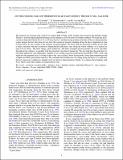| dc.contributor.author | Linares, Manuel Alegret | |
| dc.contributor.author | Chakrabarty, Deepto | |
| dc.contributor.author | Van Der Klis, M. | |
| dc.date.accessioned | 2012-04-13T15:19:23Z | |
| dc.date.available | 2012-04-13T15:19:23Z | |
| dc.date.issued | 2011-05 | |
| dc.date.submitted | 2011-02 | |
| dc.identifier.issn | 2041-8205 | |
| dc.identifier.issn | 2041-8213 | |
| dc.identifier.uri | http://hdl.handle.net/1721.1/70013 | |
| dc.description.abstract | The neutron star transient and 11 Hz X-ray pulsar IGR J17480–2446, recently discovered in the globular cluster Terzan 5, showed unprecedented bursting activity during its 2010 October-November outburst. We analyzed all X-ray bursts detected with the Rossi X-ray Timing Explorer and find strong evidence that they all have a thermonuclear origin, despite the fact that many do not show the canonical spectral softening along the decay imprinted on type I X-ray bursts by the cooling of the neutron star photosphere. We show that the persistent-to-burst power ratio is fully consistent with the accretion-to-thermonuclear efficiency ratio along the whole outburst, as is typical for type I X-ray bursts. The burst energy, peak luminosity, and daily-averaged spectral profiles all evolve smoothly throughout the outburst, in parallel with the persistent (non-burst) luminosity. We also find that the peak-burst to persistent luminosity ratio determines whether or not cooling is present in the bursts from IGR J17480–2446, and argue that the apparent lack of cooling is due to the "non-cooling" bursts having both a lower peak temperature and a higher non-burst (persistent) emission. We conclude that the detection of cooling along the decay is a sufficient, but not a necessary condition to identify an X-ray burst as thermonuclear. Finally, we compare these findings with X-ray bursts from other rapidly accreting neutron stars. | en_US |
| dc.description.sponsorship | Netherlands Organization for Scientific Research ((NWO) Rubicon Fellowship) | en_US |
| dc.language.iso | en_US | |
| dc.publisher | Institute of Physics Publishing | en_US |
| dc.relation.isversionof | http://dx.doi.org/10.1088/2041-8205/733/2/l17 | en_US |
| dc.rights | Article is made available in accordance with the publisher's policy and may be subject to US copyright law. Please refer to the publisher's site for terms of use. | en_US |
| dc.source | Prof. Chakrabarty via Mat Willmott | en_US |
| dc.title | On the Cooling Tails of Thermonuclear X-ray Bursts: The IGR J17480–2446 Link | en_US |
| dc.type | Article | en_US |
| dc.identifier.citation | Linares, M., D. Chakrabarty, and M. van der Klis. “ON THE COOLING TAILS OF THERMONUCLEAR X-RAY BURSTS: THE IGR J17480–2446 LINK.” The Astrophysical Journal 733.2 (2011): L17. Web. | en_US |
| dc.contributor.department | Massachusetts Institute of Technology. Department of Physics | en_US |
| dc.contributor.department | MIT Kavli Institute for Astrophysics and Space Research | en_US |
| dc.contributor.approver | Chakrabarty, Deepto | |
| dc.contributor.mitauthor | Chakrabarty, Deepto | |
| dc.contributor.mitauthor | Linares, Manuel Alegret | |
| dc.relation.journal | Astrophysical Journal. Letters | en_US |
| dc.eprint.version | Final published version | en_US |
| dc.type.uri | http://purl.org/eprint/type/JournalArticle | en_US |
| eprint.status | http://purl.org/eprint/status/PeerReviewed | en_US |
| dspace.orderedauthors | Linares, M.; Chakrabarty, D.; van der Klis, M. | en |
| dc.identifier.orcid | https://orcid.org/0000-0001-8804-8946 | |
| dspace.mitauthor.error | true | |
| mit.license | PUBLISHER_POLICY | en_US |
| mit.metadata.status | Complete | |
